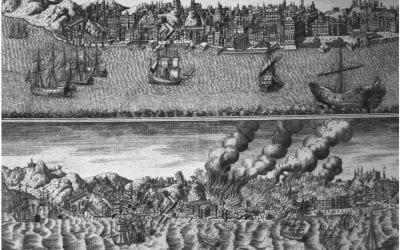Large-Scale Risks and Extreme Events
Entering the New Era
Several years ago, I was invited to give a talk in Europe to a large audience of industry representatives, government officials and experts from academia. The main topic was “new trends in catastrophe risk management and global governance.” I discussed, as I will do briefly here, what the future was very likely to look like. At the end of the speech, the organizers opened the floor for a series of questions from the audience. As one would expect, most of the questions related to the implications on countries, companies and citizens of the changes in the risk landscape I had just described. Why does it look like there are more and more catastrophes? What would be the best way for a country or a region to deal with these catastrophes? Who should pay?
One of the participants (a highly visible person in his country), however, stood up and spoke quite loudly: “accidents and natural catastrophes have always existed. There is nothing new here. I don’t see why the world has become more exposed to disasters than 50 or even 100 years ago. You’re pushing too hard.” At first I was quite surprised by his reaction because I knew he had studied these issues and that facts are now speaking for themselves. But I realized when he came to me at the cocktail party that followed, that his remarks were actually not addressed to me, but rather to the rest of the audience. “You just cannot tell them what you just told them. They are not ready for that, you will scare them!” he told me when we were talking just together.
This was in 1999, and every body was talking Y2K. The Y2K bug never happened but instead we got a series of perhaps even more destabilizing catastrophes and threats. I always remember this anecdote when I’m asked to lecture or advise on the challenges of managing and financing the new era of catastrophes we have entered.. Indeed, this gentleman had a point: (1) catastrophes are of course not new; (2) when the rules of the game change some people get scared and are afraid to recognize the new reality and act upon it. But, overall, I feel that he was wrong. While not new, the disasters we are now facing have few precedents in scale. Moreover, dealing with two or three major catastrophes in a century is one thing; dealing with 5 or 10 in a decade altogether another. Additionally, I believe decision-makers are actually less likely to be scared when they understand better what is at stake and what are the main drivers of this change. Knowledge helps develop better strategies and policies to address the emerging issues.
Here I focus on natural disasters, but similar arguments could be made for international mega-terrorism, critical infrastructure protection or pandemics.
NATURAL DISASTERS: WHY THIS IS A NEW ERA
One way to look at it is through the comparison of specific measures over time. I focus on three here: insured losses, economic losses and fatalities.
Insured losses—Catastrophes have had a more devastating impact on insurers over the past 15 years than in the industry’s entire previous history. All the figures here are in 2005-price, corrected for inflation. Between 1970 and the mid-1980s, annual insured losses from natural disasters (including forest fires) were in the $3 to 4 billion range. In the 1990s, the scale of insured losses from major natural disasters changed radically: $17 billion in 1991, greater than $30 billion in 1992 with $20 billion from Hurricane Andrew alone, more than $20 billion in 1994 with $18 billion from the Northridge earthquake, and $25 billion in 1999 mainly due to major storms and flood in Europe. A new record was reached in 2004 with $49 billion. This upward trend is continuing. In 2005, insured losses from Hurricane Katrina were estimated at $45 billion in insured losses. Worldwide, major catastrophes in 2005 inflicted $83 billion of insured economic damage, this is twice as much damage as in 2004.
Imagine now that you were to collect data on all the major catastrophes that happened in the world in the past 36 years (1970-2006). If you were to research the direct economic cost and the portion thereof covered by insurance, you would find that of the 20 most costly events (corrected for inflation) for the insurance industry, fully 10 of them occurred during the past 5 years (in constant prices). Katrina alone, which hit the Gulf of Mexico at the end of August 2005, has inflicted nearly $45 billion in insured losses. That is more than the insured cost of all the major natural disasters that occurred in the world between 1970 and 1980 combined. Just a few weeks later, Hurricanes Wilma and Rita hit the Gulf again, inflicting over $15 billion of additional insured losses. This is characteristic of the new era that I mentioned earlier.
Insured versus Economic Impact—Insurance does not decrease the global losses from an untoward event, but rather, spreads its financial impact by enabling those at risk to pay a relatively small premium so they can be protected against a large loss that has a small chance of occurring. Hence insured losses reflect only a part of the total economic damage inflicted by a disaster. Economic losses follow the same increasing trend described earlier for insured losses. The grey zones in the graph represent the average annual economic loss by decade (in 2005 prices). A comparison of these economic losses per decade reveals a huge increase: $45 billion (1950-59), $81 billion (1960-69), $148 billion (1970-79), $230 billion (1980-89) and $705 billion (1990-99). In the 2000-2009 decade, the year 2004 alone inflicted about $113 billion in economic loss, and the following year, 2005, doubled this record up to $230 billion. In other year 2005 inflict as much as all world catastrophe losses between 1950 and 1979 or as much as all catastrophe losses for an entire decade, 1980-1989.
Economic versus Human Impacts—Fatalities often do not factor into insurance loss rankings. The correlation between insured losses and fatalities is even less clear than the relationship between insured and economic losses. As a large number of natural disasters occur in the developing world or in poor areas of developed countries where there is limited insurance in place, one needs to pay attention to fatality factors independent of their impact on insured losses. For example, the tsunami that devastated South Asia in December 2004 cost the insurance industry about $5 billion, primarily from losses to tourism activities, but the disaster killed over 280,000 people and constitutes the second most deadly natural disaster event of the past 100 years (a storm and flood killed 300,000 people in 1972 in Bangladesh). A few months later, Hurricane Stan and floods that followed hit Mexico, Guatemala and other areas in South America, killing over 2,000 people; but insured losses were “only” $180 million.
More generally, the most deadly natural disasters from the point of view of human lives typically occur in developing countries. Between 1970 and 2005, for example, there were 21 catastrophes that each killed over 10,000 people; 20 of them occurred in developing or extremely poor countries.
THREE KEY DRIVERS OF THIS RECENT EVOLUTION
With the exception of the terrorist attacks of September 11, 2001, all the other 19 of the 20 most costly catastrophes of recent history were all natural disasters. Among these natural disasters, more than 80% were weather-related events: hurricanes and typhoons, storms and floods. This raises the question as to what are the key drivers of this new era of extreme events that can destroy entire regions in just a few hours, and seriously compromise the economic and social development of these regions in the long term. There are at least three main drivers of this major shift: two socio-economic factors (degree of urbanization and value at risk) and the impact of global warming. Degree of urbanization— In 1950, approximately 30% of the world’s population lived in cities. In 2000, 3 billion people, or about 50% of the world’s population, resided in urban areas. Projections by the United Nations show that by 2025, that figure will have increased to 5 billion people, or 60% of a world population estimated at 8.3 billion people. A direct consequence of this movement is the increasing number of so-called mega-cities with populations greater than 10 million (one in 1950, twenty-six by 2015), many of which are located in areas prone to natural hazards.
Value at risk—The increase in the value exposed to natural hazards amplifies the potential for severe economic and insured losses. One example is the rapid industrialized development in the Gulf of Mexico. The first off-shore oil platform for water depths higher than 100 meters was built in the 1960s. Today, there are numerous such platforms in the Gulf of Mexico and the North Sea, both of which are regions highly exposed to major storms. Indeed, fully 75% of the 4,000 platforms administered by the U.S. Minerals Management Service were in the path of Hurricanes Katrina and Rita, and many were subsequently destroyed. Hurricane Katrina shut down an estimated 95% of crude production and 88% of natural gas output in the Gulf of Mexico, inflicting major business interruption losses. According to the U.S. Department of Energy, two months after Katrina made landfall as a category-3 hurricane (August 29, 2005), the shortfall of oil production was still 1 million barrels a day, making it five times as great as the shortfall experienced two months after Hurricane Ivan, which had hit just one year earlier.
The increasing concentration of people and goods in high risk areas will continue to have a major impact on the level of economic and social consequences from natural catastrophes.
Global warming—Another possible driver of future catastrophes in North and South America—while difficult to measure—relates to global warming. One of the expected effects of global warming is an increase in hurricane intensity: Higher ocean temperatures lead to an exponentially higher water evaporation rate in the atmosphere, increasing the intensity of hurricanes. And more intense hurricanes have higher destructive power. Focusing only on the North Atlantic—that is, the Atlantic, the Caribbean, and the Gulf of Mexico—it has been shown, for instance, that Category 4 & 5 hurricanes have increased from 16 in the period from 1975-89 to 25 in the period from 1990-2004, representing a 56 percent increase. That being said, there is currently debate in the scientific community as to what are the most likely determinants of this huge increase. While some attribute the increase to global warming, others posit that it could be the occurrence of a new cycle of intense hurricane activity, as last seen in the 1940s and 1950s. A bad scenario—but a plausible one—would be that we have entered into a high cycle of more intense hurricanes to be expected for the next 15 or 20 years, reinforced by higher sea surface temperatures due to global warming. If that’s the case, my prediction is that the next 15/20 years should see an even greater number of even more devastating weather-related catastrophes than in 2004 and 2005. In other words, the worst might have yet to come.
CONSTRUCTING A NEW MODEL
Most of my remarks above draw on ongoing research undertaken at the Wharton Risk Center, especially with my colleague Howard Kunreuther, who pioneered this field. We see more and more organizations recognizing the changing nature of these risks, in our increasingly interdependent and global world. Because of limited space here, I focused on describing the new era but not on how respond to it in an appropriate way. Best practices have been developed that would be important for country and companies to consider and implement to protect their citizens and economic growth. To end I’d like to acknowledge two recent initiatives by international organizations I collaborate with. Both are based on one principle: global risks call for global answers, and for international collaboration.
With 30 of the richest countries as permanent members, the Organization for Economic Cooperation and Development (OECD), headquartered in Paris, is an important source of innovation to deal with emerging issues that impact many countries throughout the world. In June 2006, Angel Gurría (formerly Mexico’s Minister of Foreign Affairs and Minister of Finance and Public Credit) took office as the new head of the OECD. Recognizing the new risk landscape we now live in, he immediately established the High-level Advisory Board on Large-scale Risks and Disasters, composed of experts in the field and industry executives. The Board advises the OECD on key recommendations to improve preparedness and better finance the economic and social consequences of future disasters.
In the same spirit, the World Economic Forum has been working for the past two years on a new initiative to address Global Risks (see Global Risk Report 2007 on the web). These large-scale risks were an integral part of the agenda for the 2,000 top-decision makers who attended the annual meeting of the Forum in Davos at the end of January.
A new era calls for a new model. Those complementary actions are an important step toward developing a new model and constructing global reaction capacity for future large-scale catastrophes. The fact that countries and organizations are working collectively to achieve this goal should also create trust, a critical element of leadership for tackling the new challenges of the 21st century.
Winter 2007, Volume VI, Number 2
Dr. Erwann O. Michel-Kerjan is Managing Director of the Wharton Center for Risk Management and Decision Processes at the Wharton Business School. His work focuses on managing and financing extreme events. His latest book is Seeds of Disaster, Roots of Response: How Private Action Can Reduce Public Vulnerability (Cambridge University Press, 2006; www.SeedsofDisaster.com).
In 2007 he was named Young Global Leader by the World Economic Forum, an honor bestowed to acknowledge the top leaders below the age of 40 from around the world for their professional accomplishments, their commitment to society and their potential to contribute to shaping the future of the world.
Related Articles
Environmental Stress and Rainmaking
When Europeans first attempted to settle in North America north of the Rio Grande, their confrontations with Indian cultures were marked by cosmic struggles over environmental…
“Bury the dead and feed the living”
“Bury the dead and feed the living.” These were the words attributed to Portugal’s pragmatic, all-powerful first minister, the Marquês de Pombal, as he contemplated the damage wrought by…
The Jesuit and the Jew
Such a Spectacle of Terror and Amazement, as well as the Desolation to Beholders, as perhaps had not been equalled from the Foundation of the World.” Thus an English merchant writing…





